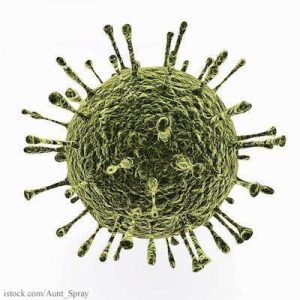Vomiting Larry is a barfing machine. And anyone who’s ever had norovirus knows exactly how that feels, even if Larry doesn’t.
 Thank goodness for Larry that he is an actual machine and can’t feel a thing, because his job is to get loaded up with fluorescent vomitus and spew it so scientists at the UK’s Health and Safety Laboratory can measure the distance his barf droplets travel to see how norovirus is spread and to prove once and for all that there really are fun jobs in the world of science. Thanks to Larry’s efforts we know that barf droplets, many of which are invisible to the naked eye, can travel more than three meters, or almost 10 feet. Each of these droplets contains thousands of particles of virus that can live for weeks on hard surfaces. It takes fewer than 20 particles to make someone sick. That’s why norovirus is universally described as “highly contagious” and, as the BBC put it, “is one of the few diseases you actually can catch from a toilet seat.”
Thank goodness for Larry that he is an actual machine and can’t feel a thing, because his job is to get loaded up with fluorescent vomitus and spew it so scientists at the UK’s Health and Safety Laboratory can measure the distance his barf droplets travel to see how norovirus is spread and to prove once and for all that there really are fun jobs in the world of science. Thanks to Larry’s efforts we know that barf droplets, many of which are invisible to the naked eye, can travel more than three meters, or almost 10 feet. Each of these droplets contains thousands of particles of virus that can live for weeks on hard surfaces. It takes fewer than 20 particles to make someone sick. That’s why norovirus is universally described as “highly contagious” and, as the BBC put it, “is one of the few diseases you actually can catch from a toilet seat.”
In addition to touching surfaces contaminated by the virus, you can also catch norovirus by eating or drinking foods prepared by someone who is infected with it or from shellfish harvested from contaminated waters. Once it’s in your system, norovirus inflames the stomach lining, causing frequent, intense bouts of vomiting and diarrhea accompanied by severe abdominal cramps. Sometimes low-grade fever, chills, muscle aches and headache also occur. Symptoms usually develop one to two days after exposure, but may appear within 12 hours.
You can catch norovirus anytime, but there is a season and we’re in it. Most of the 23 million cases of norovirus that happen each year in the US, occur between November and January. Of the millions sickened annually, an estimated 50,000 people will become so sick they require hospitalization. More than 300 of them will die, according to the Centers for Disease Control and Prevention (CDC).
Handwashing with warm soapy water for 20 seconds is the primary defense against the spread of norovirus. Clean up immediately after someone who has been sick. Wear a particle mask and use a bleach solution, the CDC recommends 5 to 25 tablespoons per gallon of hot water, for best results.




